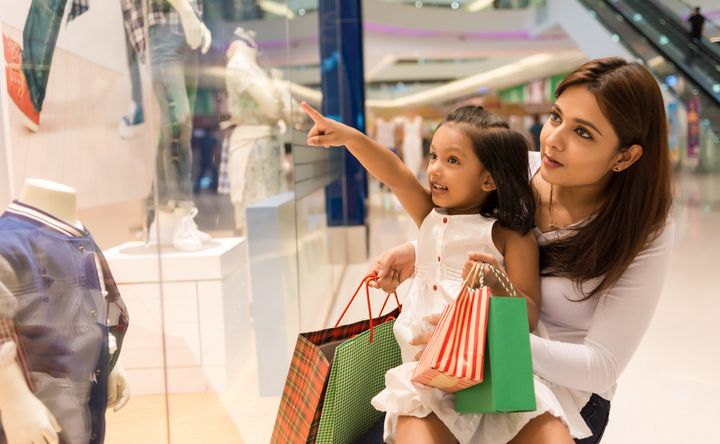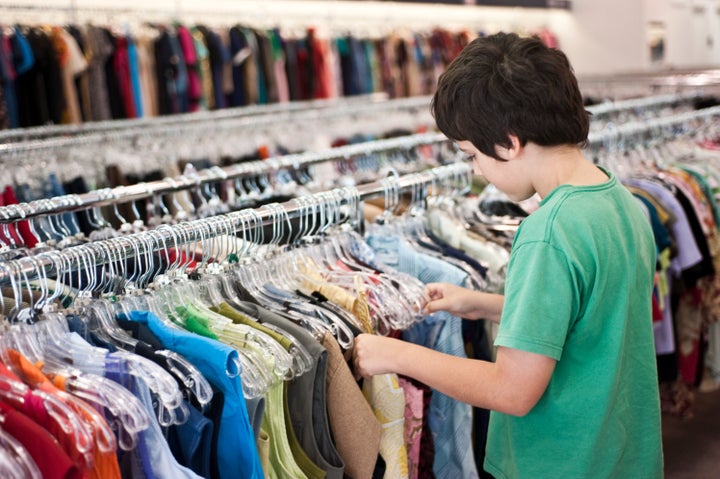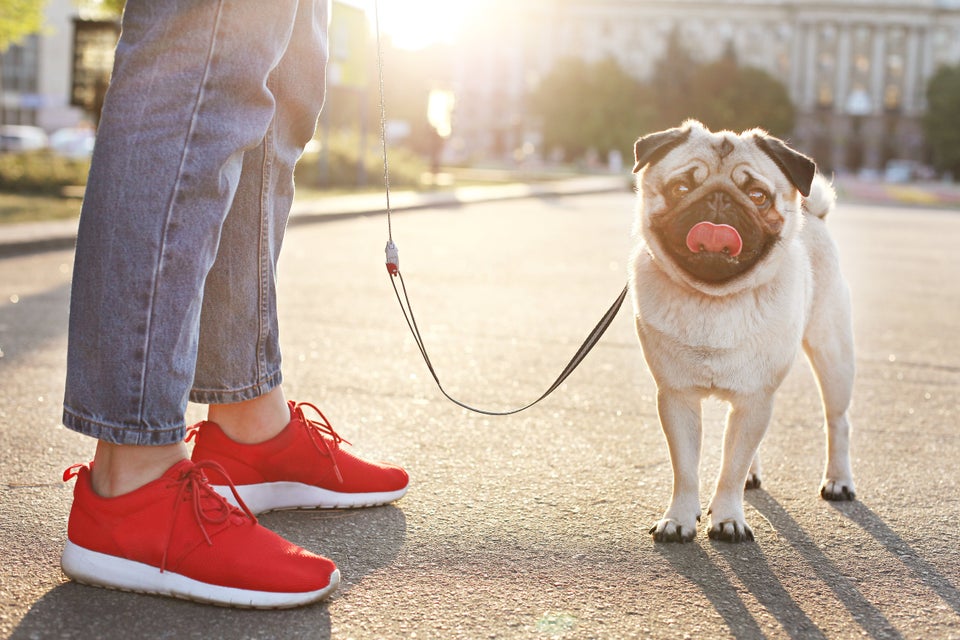
The day after I had my first (and only) baby, in 2018, I signed up for Amazon Prime and I’ve been opening boxes from the retail giant every week since. And I’m not proud of it.
I’ve been thinking a lot about how my consumption habits have changed since I became a parent, and I’ve come to the conclusion that 1. I consume a lot more than I need to and 2. There are ways to fix this.
As a new parent, and as someone who is organized to the extreme, I used Amazon Prime as a way to prepare for my baby’s milestones. When he was a month old, I bought three types of snot suckers and saline tools to prepare for his future colds (he came down with his first cold at eight months old).
WATCH: Parents face constant pressure to spend more money on their kids. Story continues below.
When he was six weeks old and refusing to sleep on anything but me or my husband, I bought four different swaddle brands, two “rest” loungers, and two swings, thinking that he would have to sleep in one of them. (Shocker: he didn’t.)
I bought dozens of PJs, onesies, shirts, pants, socks, and sweaters in sizes that were months ahead of his actual age. And it wasn’t just Amazon I was spending my EI on. Gap, Carter’s, Old Navy, as well as local baby stores and mom-run online shops got plenty of my cash, too.
It’s embarrassing to admit it, but my baby barely used many of the things I bought, either because he had no interest in them or he grew out of them within weeks. So, I started returning things I realized I actually didn’t need. Turns out, this isn’t great either.
We love little tips, how about you? Story continues below slideshow.
Your returned merchandise most likely ends up in a landfill
According to Adria Vasil, an environmental journalist, Canadians are returning $46 billion worth of product a year, which is concerning as many of this merchandise ends up in landfills.
“It actually costs a lot of companies more money to put somebody on the product, to visually eyeball it and say, Is this up to standard, is it up to code? Is this going to get us sued? Did somebody tamper with this box in some way? And is this returnable?” Vasil told CBC’s The Current. “And if it’s clothing, it has to be re-pressed and put back in a nice packaging. And for a lot of companies, it’s just not worth it. So they will literally just incinerate it, or send it to the dumpster.”
Retailers throw out unused products
A friend recently posted on Facebook that she found unsold Carter’s OshKosh B’gosh kids’ goods and clothing purposely destroyed in garbage bags in Toronto.
In her post, Natasha McKenna writes that the items “weren’t just thrown out, they were destroyed so they couldn’t be used anymore,” including items such as “sliced shoes, smashed picture frames, cut-up onesies and ripped-up snow pants and gloves.”
WATCH: Children’s store under fire over unsold clothes found destroyed in trash. Story continues below.
McKenna told HuffPost Canada that she was contacted by a Carter’s employee who said that staff “are instructed to cut up items that are returned damaged or (are) somehow damaged on the floor.”
This practice is apparently fairly common. In 2018, luxury retailer Burberry admitted to destroying $36.8 million worth of its own merchandise, and other brands, including H&M, Nike, Urban Outfitters, Victoria’s Secret, Walmart, and Michael Kors, reportedly also destroy millions’ worth of their own product every year.
So, how can we reduce our consumption to prevent waste? Here’s a list of actionable items that we as parents can do to help reduce our consumption.
1. Buy less (or don’t buy at all)
As a new parent, I was overwhelmed by all the things I thought I had to buy for my kid.
Now, I put a lot more thought into my purchases. I ask myself these questions before I buy something for my toddler: Does he really need this? Will he still use this in a few months or years? How long will he fit in this piece of clothing? Can I buy this second-hand? Can I get this from another parent?
The idea is to get me to buy less; if I realize I don’t really need the item, then I won’t buy it.

2. Shop second-hand
If I do in fact need to buy something for my son, I ask myself if I can get it from a second-hand store. Luckily, there’s a great second-hand kids’ shop down the street from me, and they have everything for kids ages newborn to 10 years old, from clothes, toys, books, stroller bags, diaper bags, costumes, baby carriers, strollers, and more.
If there isn’t a children’s second-hand store near you, check out other second-hand stores, whether it be a Value Village, or an independent thrift shop; they’re bound to have kids’ items, too. And I can personally attest to the quality of the kids’ toys at my local Value Village, which is where I get most of my sons’ toy trucks and cars. He loves them!
Alternatively, join (or start) a neighbourhood parents buy-and-sell group, and find lots of good deals!
3. Second-guess your returns
Vasil made this great suggestion in her interview with The Current, in which she says that instead of returning your item to the store you bought it from, “think about the product closely and see if there’s somebody else who [you] can give it to. If you do not want to return it, can you donate it instead?”
Organizations that accept kids’ donations include second-hand kids stores, Value Village, women’s shelters, organizations that work with refugees and new immigrants, the Canadian Diabetes Association, The New Mom Project, New Circles, and Stuffed Animals for Emergencies.
4. Make your own kids’ clothes
When I was on mat leave, I was buying gorgeous handmade baby clothes from moms who ran their own businesses. (Olive Me Handmade is one of my faves.) I was so impressed with their work that they inspired me to take up sewing lessons so I could make my kid clothes. Now, I regularly make my son pants, rompers, and bibs. My next big challenge is to make him a shirt!
The good news is that you don’t need to be a professional sewer to sew kids’ clothes. Get yourself a basic sewing machine (you can buy used through any number of buy-and-sell sites), fabric (many Value Village locations sell second-hand fabric), some thread, and start sewing clothes for your kids.
You can buy simple patterns through Etsy or your local fabric store, that will take you through how to make pants, rompers, shirts, dresses, bibs, and more with step-by-step instructions.
5. Join a zero-waste group
When I decide to make a big lifestyle change, I find it hard to commit to it over time if I don’t have someone knowledgeable who can answer all my questions.
Although my family is not even close to being “zero waste,” I can learn a lot about zero-waste practices so I can get in the habit of second-guessing my choices around consumption.
So, I joined the Zero Waste Toronto Facebook group (there are such groups all across Canada, and if you can’t find one local to your neighbourhood, create one!) to learn more about the movement. Each group has different topics of discussion (food, for example, is a major focus in the group I’m a part of) where you can find tips on how to be less wasteful.
6. Start a kids’ used goods swap
If you’re part of an online parenting group, you’ve seen parents try to give away their kids’ used clothes, toys, and that expensive swing their baby hated.
And while selling stuff online is easier and more convenient, it’s more fun to sell your used activity table in person. Invite a bunch of parents over to your place (lure them with the fact that they can leave their kids at home with a babysitter) and get to know your neighbours. Not only will you be swapping your snot sucker for cold meds, you’ll be swapping tales (hopefully over wine), too.
7. Buy from companies that make high quality products
There’s a reason why we go through a lot of clothes quickly: they’re made cheaply. If we buy from any number of “fast fashion” retailers — H&M, Zara, Joe Fresh, Forever 21, Topshop, and Urban Outfitters are just a few — inevitably we will be buying a lot of their clothes because they’re not made to last. And most of these clothes end up in the trash.
According to the New York Times, about 85 per cent of textile waste in the U.S. is incinerated or ends up in a landfill, and, because 60 per cent of fabric fibres are synthetics, they will not decay over time.
So, if you can afford it (high quality goods are on the pricier side), it’s always a great option to spend your money on companies that make clothes meant to last.
One kids’ clothing brand I love is called Mini Mioche, a Canadian company that is transparent about how their clothes are made, from the fabrics they use to the manufacturing process. Yes, their clothes will cost more than what you can get at Carter’s or Gap, but they will last a lot longer and are ethically made. Plus, when your LO grows out of them, they make cute (and much appreciated) hand-me-downs.
20 Ideas For 2020 is our series that explores easy ways to take action on the ideas and changes you may have already been thinking about.
Also on HuffPost:
